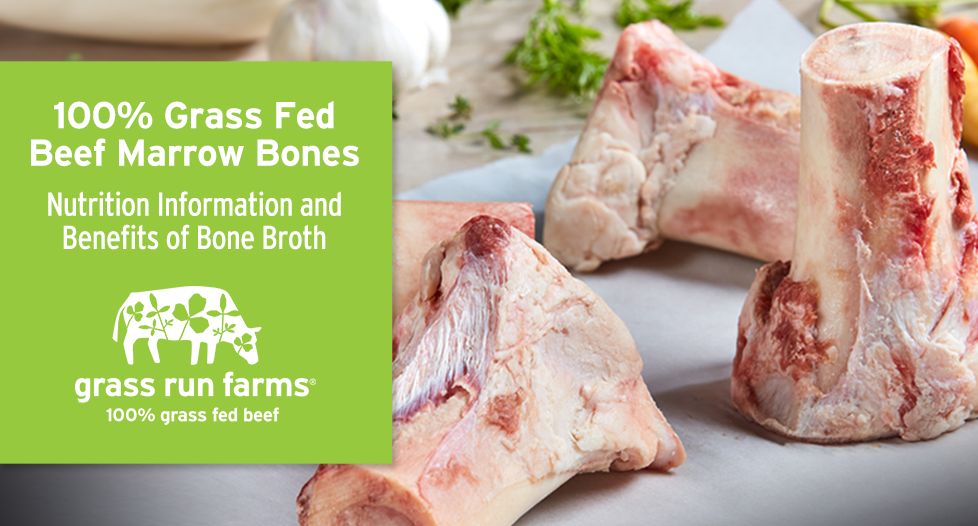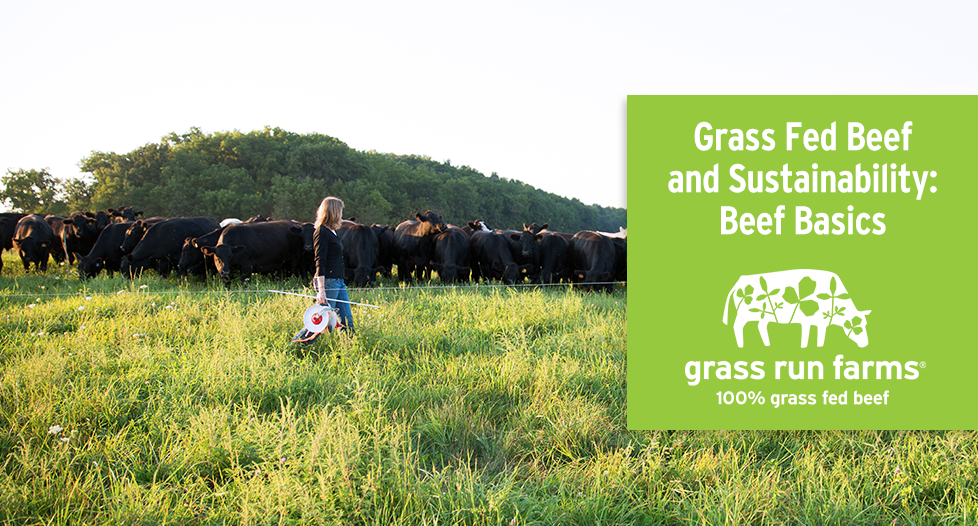July 16, 2020
Calories per serving, servings per container, how many servings did I have?
As if nutrition facts panels aren’t confusing enough, they can be even more complicated with a food you don’t consume in one piece, such as beef bones for bone marrow.
The last thing we want is for anyone to feel confused or intimidated. After all, we’re advocates for healthy, nutritious beef and are proud to offer 100% grass fed and finished beef like no other. Our mission is to provide high quality American grass fed beef and that means we share all the information you need to fully enjoy it.
Keep reading to better understand our labels and the nutrition benefits of Grass Run Farms Beef Marrow Bones!
Grass Fed Beef Marrow Bones Nutrition Information
The nutrition facts panel on our Beef Marrow Bones reflects the total contents of the beef bones by weight, meaning both the marrow as well as the bone tissue itself. In order to calculate the nutrition information displayed on our label, the bone tissue and marrow are ground together before being tested. The amounts of various nutrients indicated on this label reflect this, which explains the unusually high calcium content per 4 oz. serving.
An equivalent amount (4 oz.) of only marrow yields a very different nutrition profile:
- Less sodium
- Less calcium
- Less protein
- More fat (majority monounsaturated)
- More cholesterol
- More total calories
However, because it’s difficult to consume such a hearty portion of marrow, the current label reflects a more accurate representation of what you may end up with in a recipe for consumption.
Keep in mind labels are intended to be used as a reference or guide for food choices. When beef marrow bones are used in recipes (for example, soup or broth) the amount of marrow that will be imparted into the nutrition profile of the final dish will vary. It’s difficult to measure how much marrow different sized bones will yield. For example, a 3-inch piece of beef bone could provide anywhere from less than an ounce of marrow to nearly three ounces total. The average, however, is around 40 grams, which is equivalent to about 1.5 oz. of marrow.
Don’t let this deter you; although it’s challenging to accurately determine the exact nutrition of a particular recipe, you’ll still enjoy the benefits of cooking with beef bones and using beef bone marrow in recipes.
Note: Keep in mind Grass Run Farms 100% grass fed marrow bones are not pre-soaked, meaning there is no additional flavor or nutrients imparted on the packaged bones. The sodium, calcium, iron, and vitamin levels you see on the labels reflect what is inherently found within the beef bones.
How do I use Grass Run Farms bones?
Grass Run Farms bones, sourced from 100% grass fed cattle, can be used in a variety of recipes in your kitchen. One popular option is to roast the beef bones and serve the marrow as an appetizer spread. This is becoming increasingly popular in restaurants, but you don’t need to venture out in order for this delicacy to grace your menu for entertaining. Simply serve your roasted bone marrow with sliced bread (grilled or toasted), Kosher salt, garlic, and some fresh herbs for a dish that is sure to delight.
Our beef marrow bones are also the ideal base for DIY bone broths, such as this Homemade Beef Bone Broth. Don’t be put off by the time investment – it is well worth the wait! Homemade beef bone broth offers a simple and flavorful way to enhance the nutrition in the beef broths you use in other familiar recipes.
Roasting the beef marrow bones in a high-heat oven serves two purposes. First, it improves the flavor of your finished bone broth because the high heat will caramelize the meat and marrow within the bones. The end result: delicious, rich, full flavor that makes for a deeply satisfying taste experience.
The second purpose for roasting your beef bones is to help thicken your homemade beef bone broth. Beef bones naturally contain a protein called collagen, which is found in the connective tissues in and around the bones. When heated and simmered, these proteins are released into the beef bone broth. If you notice your homemade beef bone broth appears gelatinous and jelly-like at room temperature, congratulations! You’ve successfully captured the qualities that distinguish bone broth from other stocks and broths.
Your finished beef bone broth can be used in recipes for soups, stews, and other hearty dishes. Pair with aromatics such as onions, carrots, or celery to build deep flavor, then garnish with herbs or citrus (such as lemon) to brighten it up just before serving. Grass fed beef is a versatile ingredient that pairs well with a variety of ingredients and beef bone marrow or beef bone broth is no different!
What are the health benefits of bone broth?
One of the primary benefits of using bone broth in place of traditional broths and stocks is the enhanced amino acid profile of bone broth. Compared to stocks (which include animal bones) and broths (which do not contain animal bones), there are higher levels of essential and non-essential amino acids in bone broth.
Proteins are made of unique combinations of amino acids, which then serve as a building blocks for other issues, cells, and structures that serve various functions in the body. Essential amino acids must be consumed in the diet, as the human body is not capable of producing or synthesizing these amino acids on its own.
In beef bone broth, the five amino acids present in the greatest amounts are (in descending order): glutamine, glycine, aspartate, arginine, and alanine.1
A diet that provides adequate amounts of protein can support a healthy immune system and bone health, provide satiety, and improve the appearance of skin, hair, and nails. Additionally, protein is an important component of optimal recovery in athletes and active people.
Although beef bone broth provides more protein than a traditional broth or stock, it doesn’t necessarily mean it’s your best option for boosting your overall protein intake. Rather, it can be used alongside other familiar ingredients in your kitchen as part of a healthful eating pattern.
This is where beef bone broth can really step into the spotlight, as the flavor profile and appetizing mouth feel sets it apart. When paired with vegetables, whole grains, and animal proteins, beef bone broths can complement the other ingredients in your recipes to result in a dish that’s both nourishing and satisfying.
Grass Run Farms 100% grass fed marrow bones can be found at your local Sprouts Market. Please visit our “Where to Buy” tool to find the location closest to you.
References:
- Shaw, M. H., & Flynn, N. E. (2019). AMINO ACID CONTENT OF BEEF, CHICKEN AND TURKEY BONE BROTH. Journal of Undergraduate Chemistry Research, 18(4), 15.
- Editors, Leite’s Culinaria. (2020, February 06). Roasted Bone Marrow. Retrieved July 08, 2020, from https://leitesculinaria.com/78928/recipes-roasted-bone-marrow.html









